|

|
Useful
links:
>>Le
Mans Weather<<
>>2014 24 Hours of Le Mans live
timing & scoring<<
>>2014
24 Hours of Le Mans entry list<<
>>Andy
Blackmore's Le Mans 2014 Spotter's Guide<<
>>Radio Le Mans<<
|
|

|
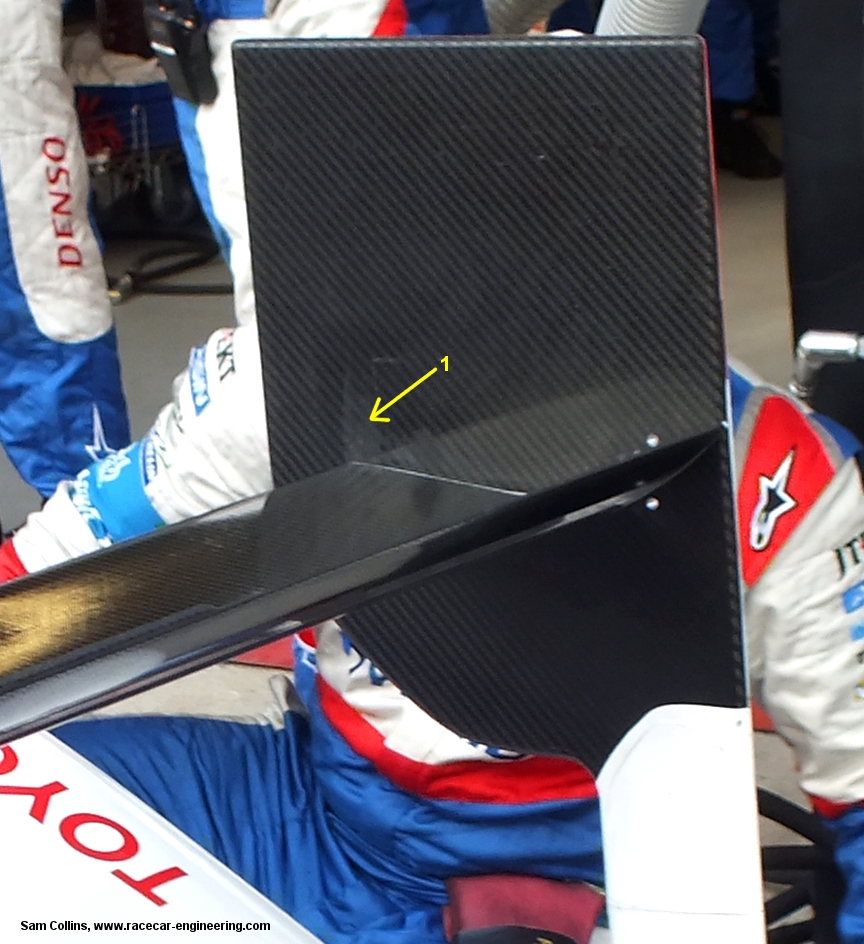 6.14-15.14 6.14-15.14
>>The
(now) open secret. So if you've just arrived here understand a
couple of things. For starters, to best grasp the discovery
process you should read from bottom to top
(go down to the 6.12 entry, read it, and then come up here to the
6.14-15 entry). That way you'll tick through the brain storming
in the correct order. It'll make more sense I think.
Secondly, this is still an active process. I think we're
80% there as to how the mechanism works (note, there is no doubt at all
about what they are doing, it's the how I'm working on), but there are
a few details to be sussed out. It'll require more data, video,
photos, etc.
So if you haven't figured out which LMP1 team is using a rotating rear wing assembly mechanism
to reduce aerodynamic drag, it's Toyota (see 6.12.14 entry below for
more details). Apparently Toyota are admitting to their
device. Go ask them about it.
While I still haven't found an image showing the device in action on
the track to my satisfaction, here's a nice tell tale of the amount of
wing movement out at the endplate. Yes, the leading edge rises that
much when the drag reduction device passivly engages.
Why this system is on the car begs the question. The FIA are
clearly aware and we've witnessed Porsche correcting their car to legal
status either under direct pressure or concerns of post-race
ambushing. This is a much bigger deal than the
flexing engine cover given the larger performance gain. And
it's a more flagrant skirting of the regulations. As I
understand it: the FIA are aware of the system, the car has
passed scutineering, and the competitors are screaming bloody murder. |
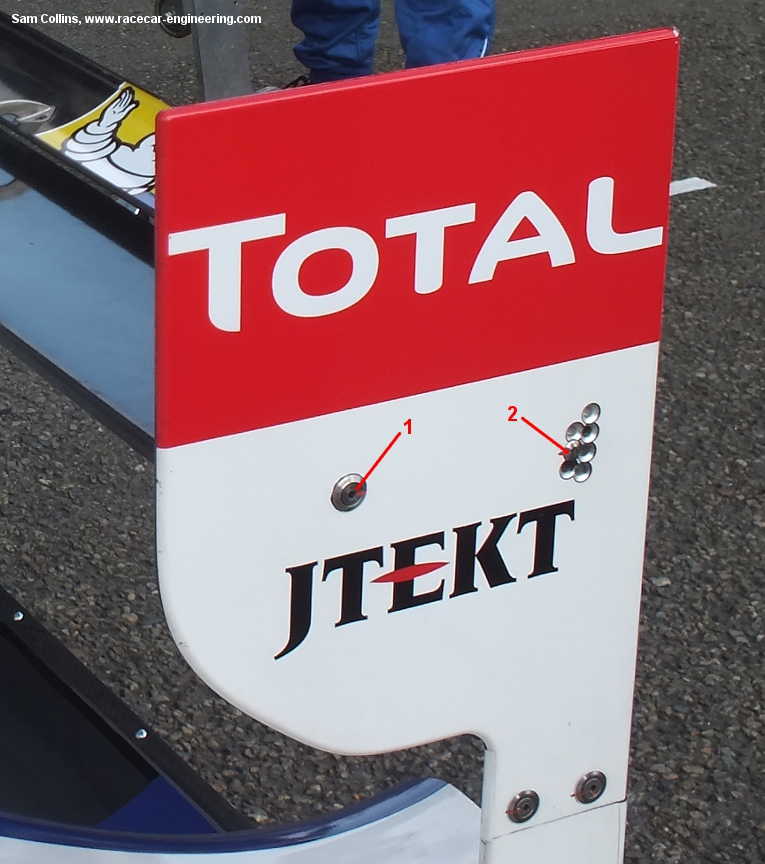 I
can't resolve the tell tale scuff marks on the inside face of the
endplate in the image above with the bolts on the outside of the
endplate and not convinced my technical description I put forth in the
6.12.14 entry below is 100% accurate. If the wing is
pivoting, then the bolts are counter intuitive to this as it would be
pinned and unable to move, right? While this is an active
brainstorm, could it be that the bolt that would secure the mainplane
(the larger bolt in the front portion of the endplate, 1) is false and
doesn't affix to the mainplane at all? And that the pivot
point is actually the bolt that runs through the flap (2)? If
that's the case, I have suspicion that there's much more to the
mechanism that moves the wing and that the endplate might have a
function. With the flap bolt (2) as the pivot point,
downward movement of the endplate would leverage the wing assembly into
a nose high attitude. That ultimately means the entire drag
reduction system is much more complex and has elements that attempt to
conceal its purpose. I
can't resolve the tell tale scuff marks on the inside face of the
endplate in the image above with the bolts on the outside of the
endplate and not convinced my technical description I put forth in the
6.12.14 entry below is 100% accurate. If the wing is
pivoting, then the bolts are counter intuitive to this as it would be
pinned and unable to move, right? While this is an active
brainstorm, could it be that the bolt that would secure the mainplane
(the larger bolt in the front portion of the endplate, 1) is false and
doesn't affix to the mainplane at all? And that the pivot
point is actually the bolt that runs through the flap (2)? If
that's the case, I have suspicion that there's much more to the
mechanism that moves the wing and that the endplate might have a
function. With the flap bolt (2) as the pivot point,
downward movement of the endplate would leverage the wing assembly into
a nose high attitude. That ultimately means the entire drag
reduction system is much more complex and has elements that attempt to
conceal its purpose. |
A
quick video mock up using what I had at the house that shows the
direction of thinking. It's not perfect, but demonstrates the
principles involved. It's pretty clear the endplate is one of
the primary functioning elements*
and it's downward movement helps leverage the wing assembly into its
nose high attitude via the pivot point on the swan neck wing mount and
the pivot point on the endplate where the secondary flap mounts.
*A
revised thought: yes, the endplates move downward, but the
contributor isn't the endplates themselves but the cheese
wedge/diffuser/engine cover is compliant to allow the wing loading to
drive them downwards. Flexible bodywork, and flexible in a
direction that I'm sure they're never tested in. |
|
|
 |
Low
speed or as load is coming off the wing. |

|
High
speed with the wing assembly rotated to a nose up attitude; the
Michelin decals are no longer visible. |
|
| The
video from which the above screen caps originate (Eurosport feed).
It shows the Toyota's wing as the car accelerates and wing
loadings increase, springing the drag reduction system into
action. This is as the wing transitions from standard
pre-load position to its low drag, nose high position. Note
the slight "bobble" as it rotates and then is in full low drag
position; the transition from standard to low drag position isn't smooth and instantaneous. It's nearly instantaneous (the video is only 3 seconds long after all), but there's a slight hesitation as the wing loading builds. |
|
|
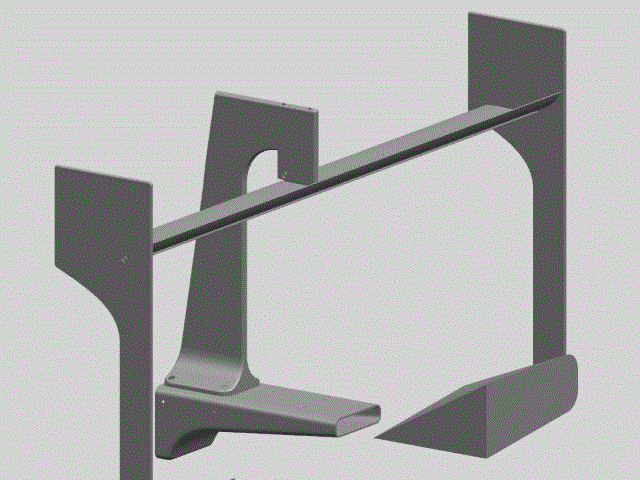 |
Nice
little animation that demonstrates the Toyota's drag reduction system.
As the wing loading increases, and because of the pivot points on the
swan neck and wing endplate, the wing pivots rearward giving it a nose
up attitude. And because the cheese wedge, diffuser, and engine cover
are flexible/compliant, it allows the endplate to sag, accommodating
the wing rotation.
|
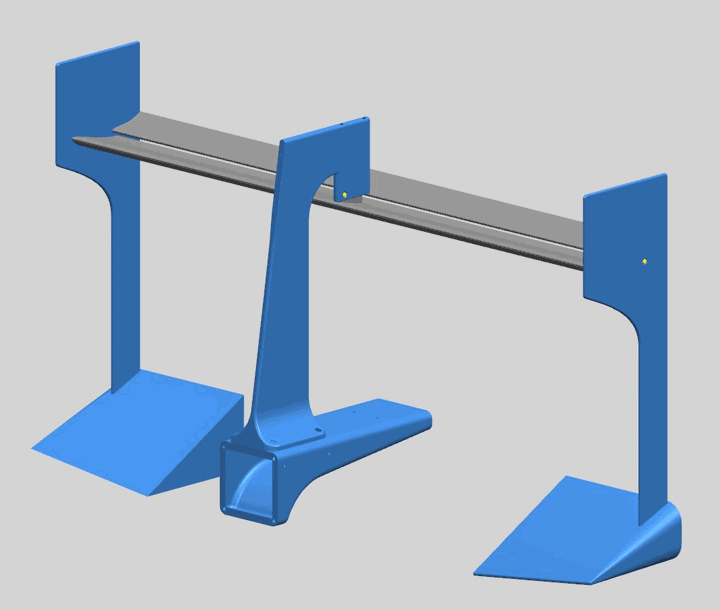 |
Animations courtesy Chris Savage, another one of the boffins on 10-10ths. |
|
| Video
showing the brief accidental activation of Toyota's drag reduction
system through chassis oscillations encountered at low speed, start at
:13. Continue watching through :32 to see the Audi R18 negotiate
the same section from the same angle. Note the wing movement on
the Toyota is fore to aft, not up and down. The wing is isolated
and moves in an entirely different plane than one would expect, this is
intentional: |
|
|
 | Gif
isolating what's interesting from the above video, again note the fore
and aft incidental
movement. This isn't an up and down or side to side movement as
you might expect with a rigidly spring wing assembly. What we see
is the wing and secondary flap
rocking back and forth as the car negotiates curbing at low speed.
Courtesy Chris Savage. |
|
 >>The
most interesting thing about the Nissan ZEOD RC. A 1.5 liter,
turbo, 3-cylinder is
very relevant to the road... >>The
most interesting thing about the Nissan ZEOD RC. A 1.5 liter,
turbo, 3-cylinder is
very relevant to the road... |
|

|
 6.13.14 6.13.14
>>Sam
went on a walk through the garages and I have a ton of shots to go
through.
A
great shot of Porsche's engine cover trailing edge fix. The
added flange (1) will no longer allow the engine cover to deflect. |
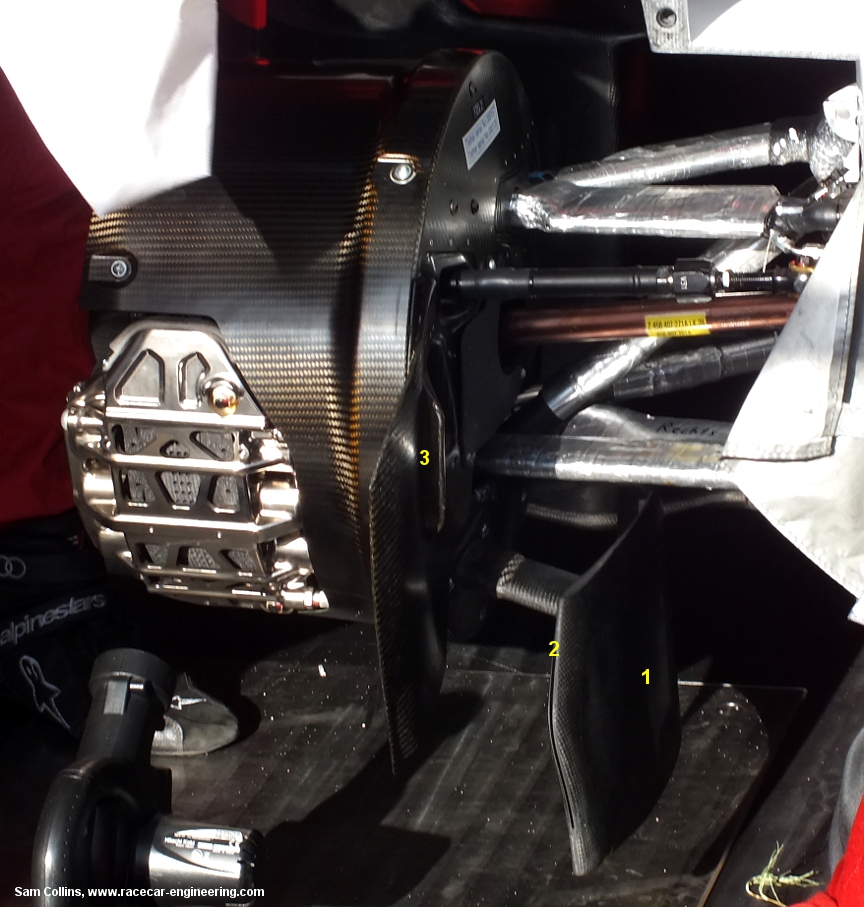 Close
up of the Audi R18's right front upright/brake cooling drum assembly.
Once again this allows prime front turning vane (1) viewing.
And as on the Porsche, Audi has given their turning vane a
secondary (yet rather cynical, given the minuscule inlet area) brake
cooling function (2). The primary brake intake (3) is reduced
in size compared to the sprint car's. Close
up of the Audi R18's right front upright/brake cooling drum assembly.
Once again this allows prime front turning vane (1) viewing.
And as on the Porsche, Audi has given their turning vane a
secondary (yet rather cynical, given the minuscule inlet area) brake
cooling function (2). The primary brake intake (3) is reduced
in size compared to the sprint car's.
And compareing it to Porsche's, it's remarkable how
similar the layout is regarding the large turning vane. |
 By
revising the cooling exit, and funneling a portion of that flow into
the openings behind the rear wheels, Audi has been able to reduce the
height of the engine bay exit along the trailing edge of the car such
that the diffuser exit and the engine cover trailing edge share the
same common point. They also are using a larger than you
would expect trailing edge gurney. But with the proximity of
the diffuser so close, the interaction must be profitable.
Add to that the engine exhaust blowing on the portions of the
trailing edge that are the lowest, all in all you can bet the R18 is
generating much more underfloor downforce to the point they can get
away with a single element rear wing. And ultimately the intention is to reduce overall drag. By
revising the cooling exit, and funneling a portion of that flow into
the openings behind the rear wheels, Audi has been able to reduce the
height of the engine bay exit along the trailing edge of the car such
that the diffuser exit and the engine cover trailing edge share the
same common point. They also are using a larger than you
would expect trailing edge gurney. But with the proximity of
the diffuser so close, the interaction must be profitable.
Add to that the engine exhaust blowing on the portions of the
trailing edge that are the lowest, all in all you can bet the R18 is
generating much more underfloor downforce to the point they can get
away with a single element rear wing. And ultimately the intention is to reduce overall drag. |
 Audi
has utilized the open area behind the rear wheels to redirect
the air exiting the engine bay (1). The air exits the engine
bay and into the wheel well through a simple gap (2) though the engine
bay airflow is segregated from the air moving out of the wheel well by
a curved turning vane (3). The wheel well trailing edge is
flared (4) to add exit area with an additional small segment (5) added
to augment. Looking into the wheel well we can see the brake
cooling drum (6). Though also note what appears to be a
strake hanging off the brake drum (7). Audi
has utilized the open area behind the rear wheels to redirect
the air exiting the engine bay (1). The air exits the engine
bay and into the wheel well through a simple gap (2) though the engine
bay airflow is segregated from the air moving out of the wheel well by
a curved turning vane (3). The wheel well trailing edge is
flared (4) to add exit area with an additional small segment (5) added
to augment. Looking into the wheel well we can see the brake
cooling drum (6). Though also note what appears to be a
strake hanging off the brake drum (7). |
 Looking
rearwards into the rear wheel well on the Ligier JS P2 LMP2 and note
the inboard louvers (1). These are grabbing air from the
wheel well and venting it in towards the engine bay trailing edge exit. Looking
rearwards into the rear wheel well on the Ligier JS P2 LMP2 and note
the inboard louvers (1). These are grabbing air from the
wheel well and venting it in towards the engine bay trailing edge exit. |
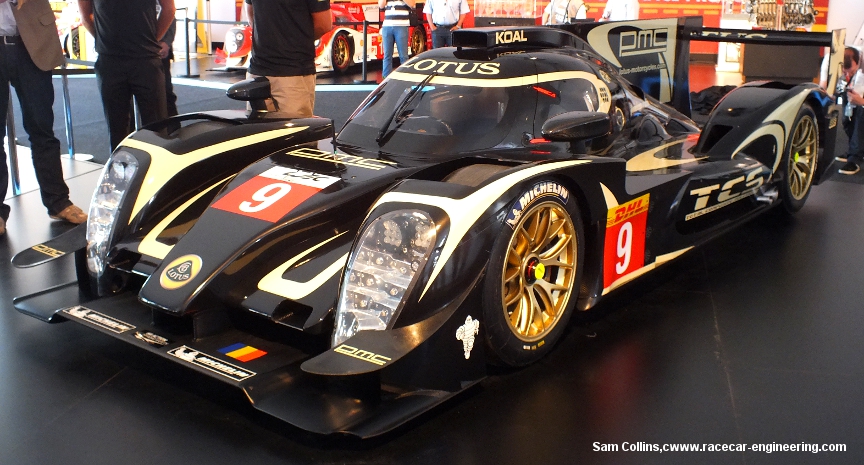 The
on again, off again Lotus T129 LMP1-L was displayed for the first time. The
on again, off again Lotus T129 LMP1-L was displayed for the first time.
|
|

|
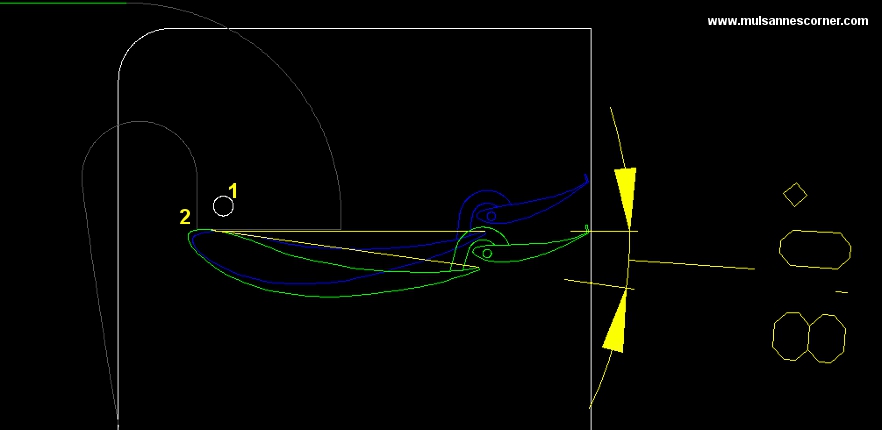 6.12.14 6.12.14
>>A
few days ahead of the Le Mans Test the FIA issued a Technical Bulletin concerning
flexible bodywork (specifically flexing of the skid) and a reiteration
of the rear wing load testing. Initially it appeared as
normal FIA house keeping. But there might have been something
else going on behind the scenes.
Race Car Engineering was first to bring attention to the Porsche 919's flexible engine cover.
Porsche had designed an engine cover that allowed the
trailing edge to deflect at speed, reducing drag.
It's my understanding that since the Test Porsche has "fixed"
the issue and the engine cover no longer deflects.
But the FIA's technical bulletin might have been issued in response to
another competitor and a controversial, if not downright completely
illegal, rear wing.
Confidential sources indicate an LMP1 competitor has designed a rear
wing assembly that rotates at speed, reducing angle of attack, and
therefore drag. It is described as such:
The
rear wing mainplane is attached to the central swan neck rear wing
mount through a single mounting point. The secondary flap
attaches to the mainplane via conventional slot gap separator brackets.
Outboard, the mainplane has a single attachment point at the
endplate and the secondary flap also has a single attachment point for
angle changes, as one would expect.
However, all is but conventional. Under load the central
portion of the rear wing rotates about that single rotation/attachment
point (1) and deflects while the outboard sections remain rigid; a
clever laminate schedule facilitates the wing rotation with the center
section being stiff (up to 50% chord width, in order to insure passing
of the deflection test--more about that in a second) with the outer
sections being "soft." The wing rotates freely until it hits
a physical stop (2). Moving the rotation point (1) through a
variety of wing mounts allows for varying degrees of wing rotation
(track dependent?).
The big question is how does it pass the deflection test?
This is actually rather straight forward. In this
case, the load test is carried out with the endplates disconnected from the bodywork
and thus the wing assembly is allowed to rotate to its stop (2) before
the load test apparatus is attached. So only normal
deflection will ever be seen. One has to wonder
what the scrutineers make of all that as clearly the way the wing
assembly is tested isn't the way the car runs
on the track... Turns out the regulations
actually mandate that the wing assembly is tested with the endplates
detached (Art 3.6.2 c/). The point being that the FIA doesn't
want the car designers to rely at all on the endplates handling the
rear wing loads in case of an accident. So sound thinking in
that regards. However, the car would still be presented at
scrutineering with a wing that was clearly out of its operating angle
of attack given the extreme nose up.
So in essence, the wing is pre-loaded into its legal position and then
is allowed to rotate to a different position when moving on the track.
Of course the relevant regulation is Article 3.4. Here's
a reminder of what it says:
Movable
bodywork parts/elements are forbidden when the car is in motion. Any
system operated automatically and/or controlled by the driver to modify
any airflow when the car is in motion is forbidden.
And analyzing the device as described
here; clearly we have moving bodywork with the intent to reduce drag (modify any airflow)
all designed to work while the car is in motion. This seems
to completely trump any ability to pass the deflection test.
And the reason we have regulations as such is to
insure competitors aren't presenting a full and legal car in
scrutineering and then allowing the car to intentionally become illegal
while on the race track. And frankly, any such device
shows malicious intent; an intent to cheat. This
isn't a clever work around, it's my opinion that it is cheating pure
and simple.
My drawing shows only 8 degrees of deflection though much more could be
occuring on track. The point is, it will be visually obvious
with the
trailing edge of the flap dropping below the leading edge of the
mainplane, a very nose up angle to the entire mainplane assembly.
So have a look and tell me what car you think is doing
this. If you have a big lens and know how to use it,
and are able to
access the higher speed portions of the track please (this deflection
will only occur at high speed), shoot away! |
|

|
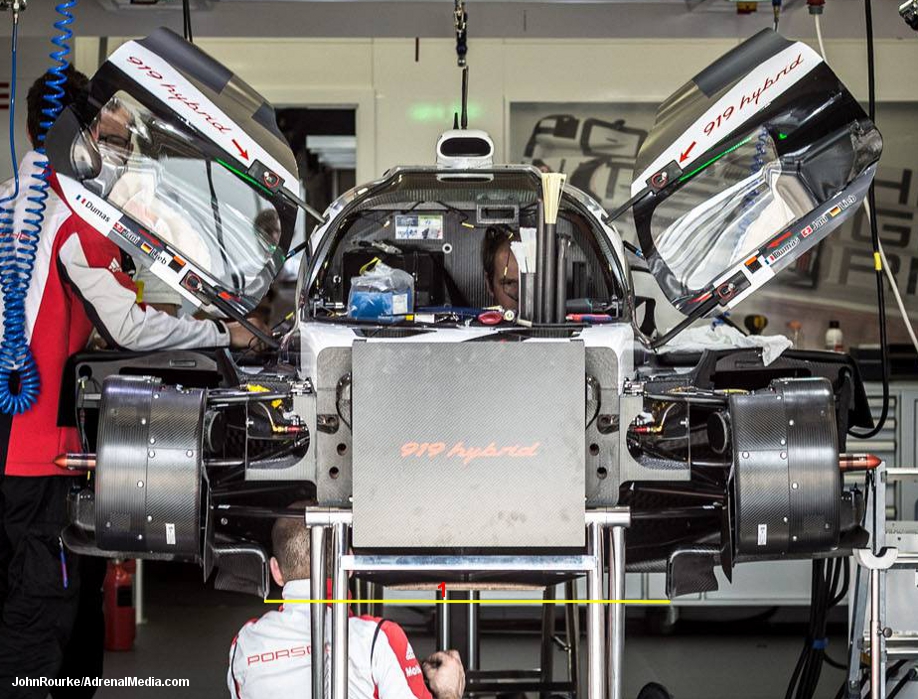 6.11.14 6.11.14
>>So
I finally have proof of the depth of the new turning vanes on the
Porsche (and similar are on the Audi, Toyota, and Rebellion). With the
nose removed and the turning vanes visible, it's evident that yes they
extend below
the reference
plane. Even accounting for camera parallax, which would be
minimal given the leading edge of the turning vane and the exposed edge
of the skid (1) are nearly on the same plane, it is very obvious the
turning vane's height isn't regulated to the reference plane. |
 >>Zytek
revealed a concept rendering of their proposed 2016 LMP2 coupe today.
The hope is to have the car testing on track by 2015 with it
race debuting in 2016. Interestingly, Zytek indicate the tub
will be LMP1 compliant. >>Zytek
revealed a concept rendering of their proposed 2016 LMP2 coupe today.
The hope is to have the car testing on track by 2015 with it
race debuting in 2016. Interestingly, Zytek indicate the tub
will be LMP1 compliant.
The design has a rather cab-forward wind screen, similar to the HPD
ARX-04b concept. The front fenders continue the vertical
leading edge trend though are slightly undercut with a large fillet to
connect the fender surfaces to the horizontal splitter surfaces.
The bodywork in between the fender and the tub has a delayed
leading edge, starting in line with the suspension. At the
trailing edge of the cockpit is a handle-bar legality structure
allowing for reduced trailing edge height while maintaining the
regulatory maximum heights.
2016 LMP2 regulations haven't been released so it will be interesting
to see how the car's and concepts evolve. However it is expected that
current 2014 LMP1 monocoque regulations will be adopted. |
|

|
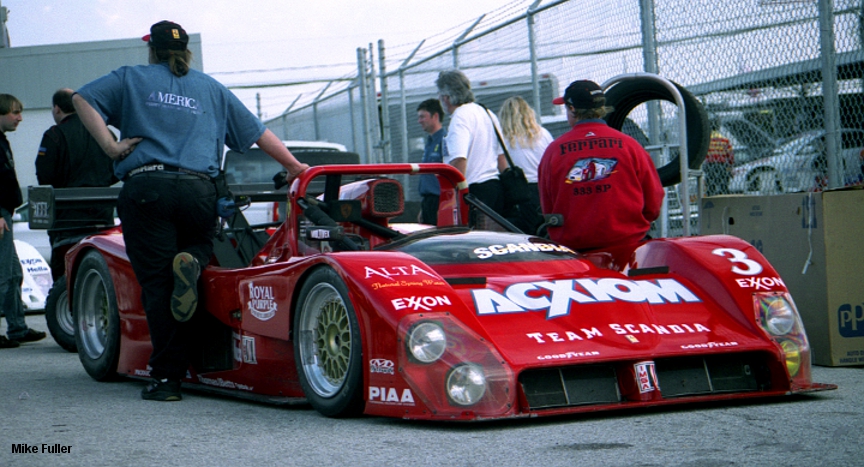 6.9.14 6.9.14
>>There's
always that race-week rumored manufacturer announcement. This
year it's none other than Ferrari to LMP1. I'll be the first
to
say Ferrari would be welcomed by all and they have such a huge Le Mans
legacy. Let's recall that Ferrari is 3rd on the Constructors
list
for most wins (9 overall, behind Audi [12] and Porsche [16]), which is
pretty impressive when you consider their last win was in 1965.
People have connected the dots with current Ferrari F1
driver Fernando Alonso being an honorary starter and turning
laps
on race day in a Ferrari 512 to Luca di Montezemolo's latest blog waxing on about Ferrari's
historic success at the 24 Hour enduro.
Frankly I think Ferrari's return would make tons of sense, to a degree.
Ferrari of course does make road cars. However,
let's
remind everyone that they're the type of road cars only say the top 1%
can afford. Thus the hybrid and fuel efficiency technology
that
might-could rub off would be...well, who cares, right? I
suspect
the average Ferrari driver indeed doesn't care. And I'll be
the
first to remind everyone what I feel about the tenuous connection of
what goes into a race car vs. how that relates to what goes into a road
car. But perhaps there's a connection to Ferrari's parent
company
FIAT? And there's no question about the cars FIAT makes and
their
relevance to the world...
But again let's remember, pure marketing is the primary reason any
manufacturer goes racing. Whatever nuanced BS they want to
say
("race developed super jumbo flux capacitors that increase MPG 400%")
is certainly their business. Has F1 suddenly become less
potent
from a marketing platform standpoint? I tend to think that it
hasn't, certainly not overnight. And
whatever downturn
F1 is currently undergoing, you'd think Ferrari would be
pretty
pragmatic about making such a lofty decision on such short term
metrics. But I'll argue, in my mind F1 vs. Le Mans
has
always favored Le Mans in regards to relevance; F1 cars look nothing
like road cars, the costs are huge to participate, and the technology
is so esoteric (though less so in recent years). However, you
still have manufacturers lining up year after year in F1.
Why?
Because F1 has reach
that ACO/Le Mans/FIA WEC does not. And
reach will always
trump relevance in regards to maximizing marketing dollar expenditures.
Thus
with it appearing that indeed, the stars really are aligned this time
and Ferrari will be coming back to Le Mans after an exceedingly long
absence...I just can't convince myself that it's true.
|
|

|
|
|

